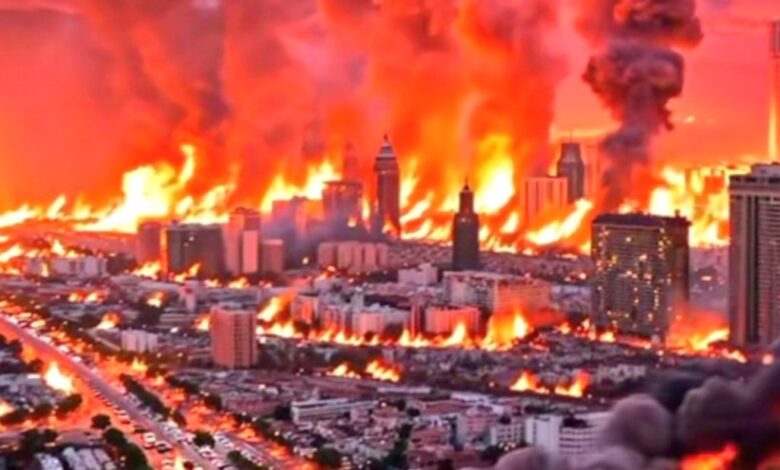
Just before dawn broke over Southeast Asia, as most people were still wrapped in the quiet of sleep, the earth unleashed a terrifying reminder of its raw and unpredictable force. A colossal 7.7-magnitude earthquake ripped through the region along the China–Myanmar border, shaking towns and cities awake with violence and leaving behind a trail of fear, devastation, and uncertainty.
The quake, sudden and merciless, began as a low rumble, the kind that could be mistaken for a passing truck or a distant storm. But within seconds it intensified into violent convulsions that sent people scrambling out of their beds, stumbling barefoot into the streets, clutching children and elderly relatives in panic. The ground itself seemed to roar, splitting open roads and reducing once-sturdy buildings into mounds of broken concrete and twisted metal. Entire communities that had gone to sleep in peace awoke to chaos.
The U.S. Geological Survey reported the quake’s epicenter at just 10 kilometers beneath the surface, a dangerously shallow depth that magnified its destructive potential. The tremors radiated outward, rippling across borders and shaking the earth beneath southern China, northern Thailand, and Myanmar. In Thailand’s Chiang Rai and Chiang Mai, panic erupted as buildings swayed, walls cracked, and terrified residents bolted for open spaces. From bustling cities to remote villages, the quake left few untouched.
In the immediate aftermath, scenes of devastation unfolded everywhere. Streets were filled with debris, cars crushed under fallen structures, and entire neighborhoods reduced to rubble. Hospitals, already straining under the sheer number of injured, struggled to keep up as waves of survivors poured in with broken bones, head injuries, and deep lacerations. Initial reports confirmed dozens of fatalities, but officials feared the death toll could rise sharply as rescuers dug through collapsed homes and businesses in search of survivors.
Rescue teams faced enormous challenges from the outset. Roads leading into the worst-hit areas were fractured and blocked, slowing the delivery of heavy machinery and relief supplies. Power outages left vast stretches of towns in darkness, while communication networks buckled, cutting off families desperate to learn whether their loved ones were safe. With every passing hour, the urgency deepened—people trapped under rubble had only so much time before dehydration, injuries, or aftershocks sealed their fate.
Despite the chaos, acts of bravery and solidarity shone through. Volunteers, many with no formal training, rushed to dig through debris with their bare hands, hoping to save strangers buried beneath. Local communities opened their doors to house displaced families, while medical workers operated in makeshift tents under the dim glow of flashlights. These moments of humanity served as fragile but powerful counterpoints to the tragedy, a reminder of resilience in the face of overwhelming destruction.
International concern quickly followed the first reports. Humanitarian agencies began mobilizing, preparing to send food, clean water, medical supplies, and emergency shelters into the affected regions. Governments around the world expressed condolences and offered assistance, but coordination remained a challenge as authorities on the ground struggled to assess the full extent of the disaster. Relief experts stressed that the coming days would be critical: the quicker aid could reach survivors, the more lives could be saved.
The human toll extended beyond the immediate physical injuries. Families were torn apart, with children separated from parents and communities losing their homes, their schools, and their sense of security. The psychological scars of surviving such a terrifying event will likely linger long after the rubble is cleared and reconstruction begins. For many, every aftershock will serve as a cruel reminder of the morning when the earth betrayed them.
Experts warn that the region remains vulnerable to aftershocks, some of which could be nearly as destructive as the initial quake. Residents have been urged to avoid unstable structures and remain in open areas, though such advice is easier given than followed when shelter, food, and water are scarce. The uncertainty only adds to the collective anxiety, as survivors grapple with both immediate survival and the looming fear of another disaster.
Natural disasters of this scale expose not only the fragility of human life but also the urgent need for preparedness and resilience. Earthquake-prone regions like Southeast Asia often grapple with inadequate infrastructure, limited emergency resources, and delayed responses that magnify the tragedy. As international attention turns toward the aftermath, experts emphasize that rebuilding must go beyond physical reconstruction. Investments in earthquake-resistant housing, disaster education, and emergency response systems will be crucial to preventing future catastrophes of this magnitude.
For now, though, the focus remains on survival. The hours and days immediately following such a quake are the most critical. Every trapped voice heard beneath the rubble represents a life that can still be saved. Every successful rescue is a victory against despair. And every act of kindness—whether a shared blanket, a hot meal, or a word of comfort—becomes part of the quiet resistance against tragedy.
The 7.7-magnitude earthquake near the China–Myanmar border has already secured its place in the region’s history as one of the most destructive natural disasters in recent memory. But beyond the numbers—of lives lost, buildings destroyed, and communities displaced—it is the human stories of survival, courage, and grief that will define this moment. The world now watches and waits, hoping that amidst the destruction, resilience and compassion will prevail.